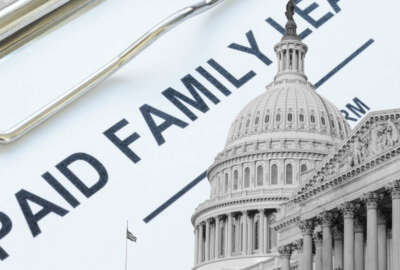
What feds need to know about the upcoming paid parental leave program
New regulations from the Office of Personnel Management detail how federal employees can use the highly-anticipated new paid parental leave program, which goes into...
The Office of Personnel Management has released more details about the new, highly-anticipated paid parental leave program, which will go into effect in less than three months.
OPM’s interim final rule, which is scheduled for publication Monday, is significant in that it gives federal agencies more instruction on how they should implement new paid parental leave benefits, and it offers employees more detail on how they can take advantage of the new program.
Under the Federal Employee Paid Leave Act (FEPLA), new benefits go into effect Oct. 1. The president signed FEPLA into law late last year, following a nearly decade-long effort by members of Congress.
“By law, paid parental leave is available to covered employees only in connection with the birth or placement of a son or daughter that occurs on or after October 1, 2020,” OPM’s regulations read. “Since paid parental leave may not be used prior to the birth or placement involved, paid parental leave may not be used for any period of time prior to October 1, 2020.”
The OPM regulations reiterate on multiple occasions: paid parental leave is only available to federal employees after the birth or placement of a new child, not before. Employees who have a new child born or adopted on Sept. 30, must use unpaid leave under the Family and Medical Leave Act or their own annual leave.
Paid parental leave was designed as a substitute for the unpaid leave federal employees have under FMLA, but only ” for periods after birth or placement of a child,” OPM said.
Employees can, however, use unpaid FMLA leave for activities not related to the birth or adoption of a new child, as well as pre-birth activities. Ultimately, federal employees are still limited to 12 weeks of leave in any 12-month period, OPM said.
“Thus, use of FMLA unpaid leave for other purposes (e.g., based on the employee’s own serious health condition or to care for certain family members with a serious health condition) can—depending on the timeframe in which it is taken—limit the amount of FMLA unpaid leave available for a birth or placement event, and thus limit the amount of paid parental leave that can be substituted for it,” OPM said.
Employees who, for example, took two weeks of unpaid FMLA leave to care for a sick parent but had a child two months later, could only use 10 weeks of paid parental leave within that year.
In addition, employees are only eligible for paid parental leave coverage if they’ve finished at least 12 months of service in the federal government.
If both parents are federal employees, each will receive his or her own 12-week entitlement of paid parental leave, according to the OPM regulations.
Employees must use their paid parental leave benefits within 12 months of the date of the birth or adoption of a new child, OPM said.
“At the end of that 12-month period, any unused balance of paid parental leave granted in connection with the given birth or placement permanently expires and is not available for future use,” the regulations read. “No payment may be made for unused paid parental leave or paid parental leave that has expired. Paid parental leave is not considered to be annual leave and thus may not be included in a lump-sum payment for annual leave following separation.”
By using these paid parental leave benefits, federal employees must agree in writing they will continue to work for their agency for at least 12 weeks after their last day of leave. The 12-week work requirement is fixed, regardless of whether the employees has used the full allowance of paid parental leave, OPM said.
Agency heads may waive the 12-week work requirement if, for example, the employee suffers a serious health condition from the birth of a new child.
For federal employees who fail to return to work after using their paid parental leave and haven’t been excused by their agencies, “the employing agency ‘may’ (but is not required to) recover from the employee an amount equal to the total amount of government contributions paid by the agency” to maintain his or her health insurance coverage, OPM said.
In its current form, FEPLA leaves out several groups of federal employees, including non-screener personnel at the Transportation Security Agency, employees at the Federal Aviation Administration and other agencies — roughly 95,000 people by OPM’s estimate.
The current law also excludes 100,000-150,000 employees with temporary appointments or
intermittent work schedules and 26,000 judicial branch employees, according to OPM.
OPM’s regulations alone can’t right those wrongs, which members of Congress have described as an inadvertent mistake in writing the original law. Congress is, however, poised to correct the law and give paid parental leave coverage to those employees in the 2021 defense authorization bill.
The House-passed version of the National Defense Authorization Act includes the necessary corrections, which appear to have bipartisan Senate support. The provisions would go in effect as if they were immediately enacted after the passage of last year’s NDAA, meaning that an FAA or VHA employee expecting a new child on or after Oct. 1 should be entitled to receive paid parental leave benefits.
OPM’s regulations are open for public comment through Sept. 9. The agency published these regulations as an interim final rule, not a proposed rule, due to time constraints in implementing the new paid parental leave law, as well as the demands on OPM to deal with sudden coronavirus pay and leave issues.
Agencies also need enough lead time to create new internal policies, make changes to their payroll systems, retrain human resources staff and give notice to federal employees, especially those who are expecting this year, OPM said.
Copyright © 2025 Federal News Network. All rights reserved. This website is not intended for users located within the European Economic Area.
Nicole Ogrysko is a reporter for Federal News Network focusing on the federal workforce and federal pay and benefits.
Follow @nogryskoWFED





